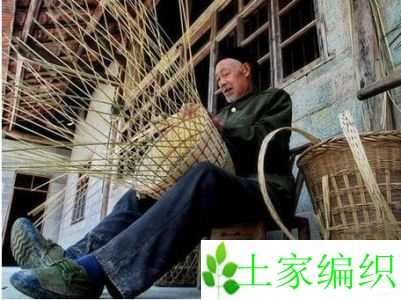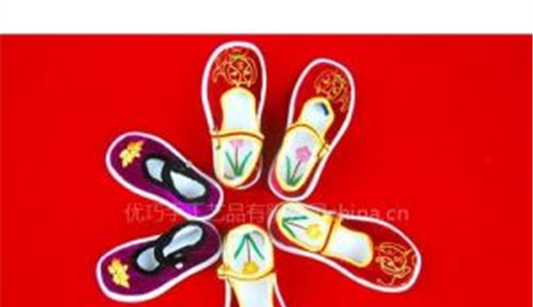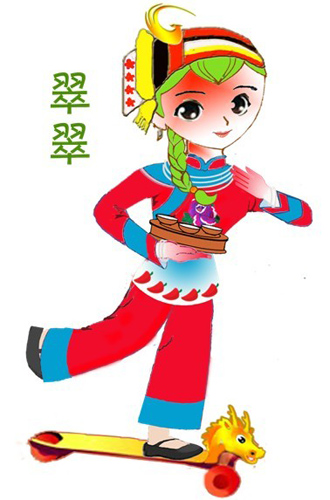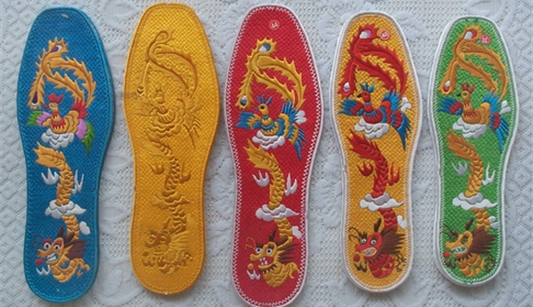Hello! Welcome to the official website of Tianxia dragon jar!Today : Tuesday, October 22, 2024 Tuesday
Hello! Welcome to the official website of Tianxia dragon jar!Today : Tuesday, October 22, 2024 Tuesday
Folk handicrafts and toys have almost become one of the indispensable contents in people's living customs. Since ancient times, its production has been mostly made by some folk artists, or generalists of men, women, old and young (such as flour flowers, tie flowers, etc.), or collective or individual operation. In all urban and rural (town) markets, shopping malls (stores), vendors and miscellaneous equipment, there are handicrafts and toys with various mechanisms or exquisite handicrafts.
Tujia weaving technology

Tujia weaving technology can be roughly divided into three categories: rattan weaving, straw weaving and bamboo weaving. Rattan weaving: Qingshui county is located in a mountainous area with many rattan plants. The weaving techniques of Tujia people in Qingshui county can be roughly divided into three categories: rattan weaving, straw weaving and bamboo weaving. Rattan weaving: Qingshui county is located in a mountainous area with many rattan plants. It mainly collects green rattan, cotton rattan and peeled to become woven materials. According to Tujia people's living habits and applicability, it is woven into rattan boxes, Rattan Baskets, rattan chairs, rattan plates, rattan mats, rattan schoolbags, etc. Straw weaving: Tujia ancestors and even the initial era of mankind have an indissoluble bond with grass. I live in a grass shed (dog shack) and sleep in a grass nest. The weaving of grass comes into being with people's needs. Grass clothes: Grass clothes and straw hats were originally woven. The traditional drama dance "Maogusi" of Tujia nationality is the primitive clothing straw clothes or brown leaf clothes. Nowadays, rain gear is still widely used to "cover the wet". Straw sandals are the most common straw woven. In Tujia language, it is called "Ji Kusu" (beating straw sandals). Tie a triangular curved wood around the waist, arrange the straw sandals into four roots, put a horizontal wooden rod on the curved wood, pedal and fix it into a support with the lower ends of two thumbs, rub the straw tightly with both hands, weave and pull it back and forth on the straw rope, and plant ears, which can be woven and used. It's hot to wear straw sandals. It's cool and light without hurting your feet. It's not easy to slip in rainy days. There are also straw mats, grass stools and grass toys. The dog tail can be used to weave the dog, which can flow. Connect the straw and weave long straw dragons. You can play dragon lanterns during the Spring Festival. Bamboo weaving: there are many bamboos in Qingshui, and there are many kinds of bamboos, which provides natural and rich materials for the bamboo weaving industry. Qingshui's bamboo weaving began with the primitive "holding and rubbing" (hunting). Bamboo is easy to bend, cut and knot. It is a good material for fencing. Human development, the needs of life. People use the properties of bamboo to weave all kinds of daily necessities. Tujia bamboo weaving technology can be roughly divided into three categories. 1. Classification of bamboo strips: draw bamboo strips into strips, remove repeated bamboo strips, and weave baskets, bumps, mats, mats (mattresses), baskets, boxes, etc. and decorations with green bamboo strips. 2. Classification of wire strips: use a steel knife to take strips, which are as fine as hemp thread and as flexible as steel wire. It mainly weaves flower basket, rice basket, back cage and children's cradle (nest barrel), etc. When a Tujia girl gets married, she has to send a delicate back cage (he has to stand on his back) to be carried by touching rice. When the three dynasties returned, the groom visited his father-in-law and mother-in-law on his back. After giving birth to a child, the grandmother's family will send a baby back cage, and the grandson will be brought up by this back cage. This is the cultural connotation of "small back basket". The most characteristic is the bamboo cradle (nest barrel), which is beautiful in style, light and stable. The baby sleeps comfortably and safely. Coupled with the beautiful lullaby, it shakes the sweet dreams of childhood, shakes the funny years, and gives rise to the pillars of talent. 3. Comprehensive category: bamboo tubes, bamboo pieces, bamboo strips, flat strips, silk strips, etc. are combined to make tables and chairs, stools, flower racks, bamboo beds, bird cages, toys and other handicrafts.
Hand embroidered shoes

Pure manual embroidery has unique artistic value and shows national customs. It is a high-quality handicraft product. The patterns come from traditional folk mascots and beautiful legends, showing the cultural characteristics of ethnic minorities and the details of folk art. The insole is made of full cotton cloth with six layers up and down. The process is fine. It can be washed and rubbed arbitrarily without wrinkling and deformation. The raised silk thread on the insole has a good massage effect on the sole of the foot. It is soft, breathable, absorbs sweat, deodorizes, nourishes the feet, relieves fatigue and health care. We provide high-quality pure manual embroidered insoles / embroidered shoes / Embroidered Lace / BADGES / murals / wholesale and agency. Embroidered insoles are a traditional handicraft of ethnic minorities. The workmanship is pure manual. A pair of exquisite embroidered insoles can be embroidered in 5-7 days by skilled Miao women. Each pair of insoles is made of six layers of new pure cotton cloth, refined with the above silk thread or pure cotton thread, and the thread material is polyester thread, Therefore, it is brush resistant and washable. The thickness of each pair of insoles can reach 4mm, and there are about 15000 raised pins on the surface, which can play a good massage role for the foot to relieve fatigue Embroidered shoe pad has the characteristics of thick, soft, comfortable, wear-resistant, odor proof, Han absorption and good air permeability. Because of its good air permeability, it has a certain therapeutic effect on people with foot sweat and beriberi. With high ornamental and collection value, it is not only a home decoration, but also a gift for friends and marriage! The patterns and styles of embroidered insoles are diverse. Flowers, plants, insects, fish, animals, plants and natural landscapes can be transformed into the scenery on the insoles through dexterous hands
Tujia vector map

Vector graph, also known as object-oriented image or drawing image, is mathematically defined as a series of points connected by lines. Graphic elements in vector files are called objects. Each object is a self-contained entity with attributes such as color, shape, outline, size and screen position.
Vector graph draws graphics according to geometric characteristics. The vector can be a point or a line. The vector graph can only be generated by software, and the file occupies less internal space, because this type of image file contains independent separated images, which can be recombined freely and unrestricted. Its characteristic is that the enlarged image will not be distorted and has nothing to do with the resolution. It is suitable for graphic design, text design, some logo design, layout design and so on.
Wool Knitting

Wool knitting is a traditional and popular handicraft, which can be made into various wool products, such as sweaters, hats, scarves and other clothing products.
Tujia insole

Tujia people's insole technology can be divided into needle and embroidery. From cloth to pattern, from color matching to needle and thread routing, everything is very particular. Often a pair of beautiful and strong insoles is the standard to evaluate a woman's ability. The handmade insole is also a token of affection for Tujia girls. If a Tujia man likes a girl, he will chat up and ask if he can give a pair of insoles. If the girl agrees, the marriage will be almost half successful. If you accidentally receive the insole from Tujia girl, hehe, it may be
It is reported that the insole with manual needle is first pasted with high-quality white linen pulp for six to eight layers, which is very strong and breathable. After drying, cut it into insole style, cover the top layer with fine plaid cloth, and then wrap it with white cloth or silk thread. The next step is to choose patterns. The most common is the xilankap style imitating brocade. This pattern is simple, colorful and has a strong Tujia style. In addition, there are characters, landscape flowers and birds, animals, characters and so on. After choosing the pattern, then the color matching. The same pattern can be matched with different colors. Each matching shows personality and full charm. In the whole production process, the most important thing is needlework. The small square on the front of the insole is full of crossed "cross" stitching, which is matched with silk threads of different colors according to the pattern, and the back is a neat "well" stitching. A good pair of insoles can be seen not only from the front, but also from the back. This requires a very high level of needlework. Every stitch must be tied to the right position. There are thousands of small squares on a insole. Each small square contains four stitches. It's not too much to describe it with thousands of stitches and ten thousand threads. The most capable woman needs about five days to receive a pair of insoles.
Tujia handmade insoles are not careless from material selection to production. In addition to being natural and simple, beautiful and generous, they are also durable. Pay attention to maintenance and can be used for more than 10 years. From the perspective of modern medical care, the raised silk thread on the insole has a good massage effect on the soles of the feet. It is very comfortable to walk. It also has the functions of odor prevention and sweat absorption, and has high practical value; As a handicraft, she has high collection value and is a top-grade gift for relatives and friends!
Silankap

Fabric: Tujia language "xilankap" is a kind of Tujia brocade. In Tujia language, "Xilan" means bedding, "Kapu" means flower, "Xilan Kapu" means flower bedding of Tujia people. People often put the word "Earth" before the "flower blanket" to indicate the ethnic characteristics of Tujia nationality contained in this folk craft. The earth flower blanket is cherished by the Tujia people. It is regarded as the crystallization of wisdom and skills, and is called "the flower of Tujia". According to the Tujia custom, Tujia girls used to make beautiful "xilankap" on the weaving machine when they got married, that is, earth flower bedding.